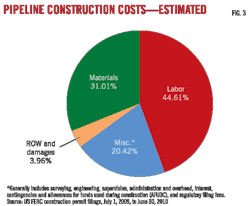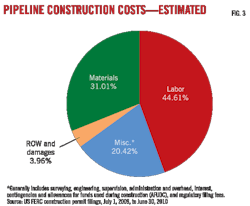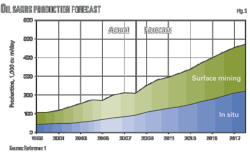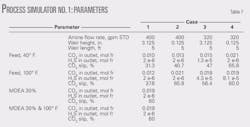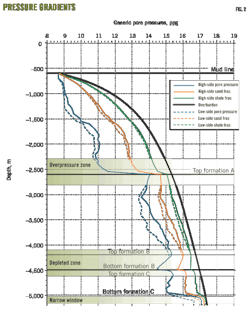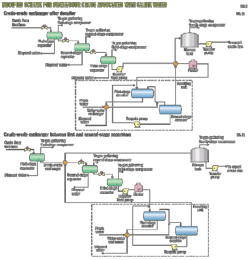Keith H. James
Consulting Geologist
Covarrubias, Spain
Sandrea1 discussed possible reserves remaining to be found in the world's deepwater areas with a most likely scenario for discovery of 50 billion bbl down to 4,000 m of water "beyond which most parts of the world do not carry sediments."
US Geological Survey global reserve estimates are based upon conventional perception of the extent of continental crust below the sea—most submarine crust is oceanic and uninteresting. Reconstructions of Pangaea, the supercontinent that existed until Triassic rifting and Jurassic drift, show assemblages unrealistically on one side of the planet (http://www.google.es/images?q=pangaea&oe=utf-8&rls=org.mozilla:en-GB:official&client=firefox-a&um=1&ie=UTF-8&source=univ&ei=oxdDTbbcHNKr8AOk7dVO&sa=X&oi=image_result_group&ct=title&resnum=2&ved=0CDgQsAQwAQ&biw=1098&bih=728) and laud "tight fit" of reconstructions practically at the coastline. They leave little leeway for exploration below the deep sea.
This article describes a rationale for industry to be more optimistic and explore wider and deeper.
Indicating the way forward are recent major, salt-related deepwater discoveries in the Gulf of Mexico (Jack, 2004, 2,000 m water, 3-15 billion bbl of reserves) and in Brazil's Santos basin (Lula—formerly Tupi, Carioca-Sugar Loaf, Jupiter, 2007, Libra, 2010, below 2,000+ m of water, perhaps 70 billion bbl recoverable, already surpassing Sandrea's likely scenario). Currently estimated Carioca-Sugar Loaf reserves of 33 billion bbl rank third behind the world's largest fields, Ghawar and Greater Burgan, discovered 60-70 years ago! The message is clear—deep water is very interesting.
The geology is there to be read—an example
Convention sees the Caribbean Sea (depths to 5,000 m) floored by basaltic oceanic crust, thickened into an oceanic plateau.
However, thorough and holistic study of Caribbean geology (crustal thickness, silicic rock chemistry, regional tectonic fabric, seismic and gravity data, stratigraphy, palaeontology) shows that it is floored by extended continental crust.2 It shares history with the Gulf of Mexico and the US eastern offshore.
Seamounts interpreted in the light of the oceanic model look more like the salt diapirs of the Sigsbee Knolls in the Gulf of Mexico.2 Where there is salt, often there is oil. The area is rimmed by oil shows and bounded north and south by huge reserves of the Gulf of Mexico and northern South America.3 4 Large gas fields lie below southern waters. Those who believe the oceanic model will never find hydrocarbons here; they won't even look.
Other areas of unsuspected continental crust?
Figs. 1 and 2 show magnetic data over North America and Europe.
The illustrations are derived from the Korhonen et al.,5 "Magnetic Anomaly Map of the World." This compiles magnetic anomaly data (1% of the total magnetic field), which the authors attribute to metamorphic and igneous rocks in the crust and upper mantle and their redox state. It is important to note that the map combines near-surface data with satellite and oceanic models and that data are extrapolated in some areas. The published map describes techniques used.
The figures show distinct signatures of high magnetic contrasts over the ancient shield areas in North America and Fennoscandinavia. They contrast sharply with the rifted (Triassic) and extended areas offshore North America and Europe southwest of the Teisseyre-Tornquist Line (an interestingly parallel trend forms the southern margin of the Labrador Sea, Fig. 1).
Fig. 3 shows South America-South Atlantic-Africa. Magnetic striping in the center of the area, produced by the oceanic model, is thought to record Mid-Atlantic Ridge spreading. The stripes ("C-Series of 33 magnetic chrons") are believed to have formed since the Late Cretaceous (84 Ma) recording flips in Earth's magnetic field polarity. The Series derives from a synthetic South Atlantic magnetic anomaly model based on a single track across the South Atlantic, with added details from Pacific and Indian Ocean magnetic profiles.6 7
The submarine areas between the striped area and subaerial South America and Africa are areas where the oceanic model does not work. Data here are near-surface and-or satellite model. These areas are seen to have formed during the Cretaceous Superchron or Quiet Period when Earth's magnetic field supposedly remained stable for some 40 million years instead of continuing its average 700,000-year polarity flip, hence the lack of magnetic stripes. However, Fig. 3 shows that the areas are startling extensions of the magnetic signatures of onshore South America and Africa into the South Atlantic.
What is the nature of this crust? Wedges of seaward-dipping reflections typify submarine extended continental crust.8 9 They are common in the North and South Atlantic.10 Many see these as composed of volcanic/volcaniclastic rocks and, indeed, basalt has been drilled off Norway. Nevertheless, they are developed in extended continental crust, and sediments also are present.
In the well-documented eastern seaboard of North America, seismic and drilling data show geology of rift basins and wedges of sediments overlain by salt, limestones, and clastic sediments (Fig. 4).
In Brazil`s Santos basin, Lower Cretaceous synrift, lacustrine carbonate reservoirs of major recent discoveries are associated with tilted fault blocks 7 km below sea level. Shallow-water limestones at this depth testify that extended offshore parts of the South American continent have subsided deeply.
The Korhonen et al. map5 indicates other, large areas in the world with similar magnetic signature, suggesting vast areas of unsuspected, extended, and subsided continental crust below the oceans. In accord with this, literature describes abundant data showing the presence of continental crust (crustal thickness, seismic architecture, dredged/drilled rocks), with history often beginning with Triassic-Jurassic rifting. Many seismic illustrations of "seamounts," premised upon "oceanic" geology, look more like salt diapirs.
East African Mozambique Channel
The Mozambique Channel off East Africa presents an interesting example (Fig. 5). Larger than the North Sea in area, up to 950 km wide and 4,000 m deep, it carries sections as thick as 11 km, extending back to Carboniferous-Triassic-Jurassic rift deposits. They include Permo-Triassic, Jurassic, and Cretaceous source rocks and Jurassic salt. Farther north off Somalia, continental crust extends at least 500 km to oceanic depths.
Beyond the continental slope, seafloor topography and gravity anomalies show structures analogous to those on land.11 Salt diapirs are present in northern Kenya and Somalia.12
The large island of Madagascar lies on the eastern edge of the channel. The map shows the island to be an exposed part of in situ continental crust off East Africa. It did not migrate NE or SE from Africa during seafloor spreading as literature debates. It has always been where it is now, as correctly concluded by Kamen-Kaye.13
Ancient mammals common to Madagascar and the mainland crossed via continental connection as recently as the middle Eocene-early Miocene.14 They did not have to swim or float on vegetation mats15 across the 400-950 km wide Mozambique Channel.
Madagascar has a western series of rift basins containing rocks as old as Permian in sections more than 11 km thick. In these basins the Bemolanga and Tsimiroro deposits contain 21 billion bbl of tar and 8 billion bbl of heavy oil.
On the other side of the Mozambique Channel large gas fields (Pande, Temane, etc., 5.5 tcf) are present in Mozambique. This East African area is becoming an exploration hot spot, with recent large gas discoveries off Mozambique and Tanzania (Windjammer, Barquentine, etc.). Liquids also seem to be present (Ironclad).
Geopolitics: writing on the wall
Melting ice and increased accessibility focus attention on the Arctic, where the USGS estimates a 50% chance of finding 83 billion bbl of oil.
At the September 2010 meeting titled "The Arctic: Territory of Dialogue," in Moscow, Canada, Denmark, Norway, Russia, and the US discussed extensions of their continental areas below Arctic waters. Canada and Russia both consider the Lomonosov Ridge theirs, and both plan to make claims before the UN maritime law commission by 2013. In 2007 Russia planted a flag on the ridge and retrieved rock samples showing its continental nature (http://news.nationalgeographic.com/news/2007/09/070921-arctic-russia.html). BP is joining Rosneft to explore the Russian Arctic.
The Arctic debate heralds an enormous problem: international drama over how much continental crust lies below the oceans and to whom it belongs. Some examples follow:
• The Institute for Research on Earth Evolution and the Japan Agency for Marine-Science and Technology consider that seismic data over the Mariana arc-backarc show oceanic crust evolving into continental crust.16 The process "could be a basis for extending (Japan's) continental shelf territory."
• Symonds et al.17 studied the Kerguelen Plateau, 4,200 miles south of India's southern tip, to define the extent of Australia's claim to "legal" continental shelf beyond the 200 nautical-mile Australian Exclusive Economic Zone. They predict that Australia will be able to claim sovereign rights to seabed and subsoil resources over 75% of the plateau.
• The Seychelles government has submitted a preliminary claim to continental crust beyond the 200-mile limit surrounding Aldabra Island.18
• Argentina remains frustrated by UK exploration in the Falklands/Malvinas area.
These activities and data discussed here suggest that international law on "natural prolongation of land territory" will need to be revisited. Rock samples indicate presence of continental rocks19 20 even in areas of magnetic striping—perceived oceanic spreading crust. The territorial debate could eventually extend to midocean ridges. The world political map will change drastically.
The future
The data discussed in this article not only indicate that unrecognized large areas of subsided and extended continent offer great hydrocarbon potential, they also suggest that the plate tectonic paradigm underpinning much geological thinking of the last 45 years needs revision.
They indicate that there was no South Atlantic "spreading" to record polarity reversals before the Late Cretaceous—"Quiet Period" crust is extended continent.
Fig. 6 is an approximate South America-Africa reconstruction based on Fig. 3 and assumptions that magnetic striping ("oceanic") records extreme extension (β ≥5) and submarine continent is extended to around twice its original area (β ≥2). For simplicity, the figure simply removes the entire striped central area of Fig. 3.
The reconstruction indicates that the amount of "continental drift-seafloor spreading" in conventional plate tectonic reconstructions is greatly overestimated. Pangaea was much larger than presently perceived. There are important implications for palaeogeography, palaeooceanography, and distributions of flora and fauna.
A change of thinking might result in important new ways to see submarine geology and its potential resources.21 How much extended continental crust is present below the oceans? When and how did it evolve? Where are the sweet spots?
Fortunately, industry is not model driven.3 It is steadily stepping into deeper water and finding major reserves. Latest generation deepwater rigs are rated to 4,000 m of water. I anticipate that we shall encounter data, via seismic and the drill, that will change the way we see the world and its evolution. Perhaps also we are about to enter a new phase of hydrocarbon exploration/discovery, and peak oil is far distant.
References
1. Sandrea, R., Sandrea, I., "Deepwater crude oil output: How large will the uptick be?," OGJ, Nov. 1, 2010, pp. 48-53.
2. James, K.H., "In-situ origin of the Caribbean: discussion of data," in James, K.H., Lorente, M.A., and Pindell, J., eds., "Origin and evolution of the Caribbean Plate," Geological Society of London, Special Publications, Vol. 328, 2009, pp. 75-124.
3. James, K.H., "Enterprise drives exploration," OGJ, Mar. 24, 2008, p. 12.
4. James, K.H., "Caribbean has overlooked hydrocarbon potential on North America's doorstep," OGJ, May 5, 2008, pp. 46-48.
5. Korhonen, J.V., et al., "Magnetic Anomaly Map of the World," Commission for the Geological Map of the World, Paris, 2007.
6. Cande, S.C., and Kent, D.V., "A new geomagnetic polarity time scale for the Late Cretaceous and Cenozoic," J. Geophysical Res., Vol. 97, 1992, pp. 13,917-51.
7. Ogg, J.G., "Magnetic Polarity Time Scale of the Phanerozoic," in Ahrens, T.J., AGU Reference Shelf 1, "Global Earth Physics, A Handbook of Physical Constants," 1995, pp. 240-70.
8. Hinz, K., Line BFB (24-fold stack) from the Norwegian continental margin/outer Voring Plateau, in Bally, A.W., ed., "Seismic Expression of Structural Styles—A Picture and Work Atlas," AAPG Studies in Geology 15, Vol. 2, Sec. 2, 1983, pp. 3-39.
9. Rosendahl, B.R., Meyers, J., and Groschel, J., "Nature of the transition from continental to oceanic crust and the meaning of reflection Moho," Geology, Vol. 20, 1992, pp. 721-24.
10. Jackson, M.P., et al., "Role of subaerial volcanic rocks and mantle plumes in creation of South Atlantic margins: implications for salt tectonics and source rocks," Marine and Petroleum Geology, Vol. 17, 2000, pp. 477-98.
11. Kent, P.E, "The Somali ocean basin and the continental margin of East Africa," in Nairn, A.E.M., and Stehli, F.G., eds., "The Indian Ocean. The Ocean Basins and Margins," Plenum Press, New York, 1982, pp. 185-204.
12. Rabinowitz, P.D., Coffin, M.F., and Falvey, D., "Salt Diapirs Bordering the Continental Margin of Northern Kenya and Southern Somalia," Science, Vol. 215, No. 4533, 1982, pp. 663-65.
13. Kamen-Kaye, M., "Mozambique-Madagascar geosyncline, I: Deposition and architecture," Journal of Petroleum Geology, Vol. 5, Issue 1, 1982, pp. 3-30.
14. McCall, R.A., "Implications of recent geological investigations of the Mozambique Channel for the mammalian colonization of Madagascar," Proc. R. Soc. Lond. B, Vol. 264, 1997, pp. 663-65.
15. Rabinowitz, P., and Woods, S., "The Africa-Madagascar connection and mammalian migrations," Journal of African Earth Sciences, Vol. 44, Issue 3, 2006, pp. 270-76.
16. Takahashi, N., Kodaira, S., Klemperer, S.L., Tatsumi, Y., Kaneda, Y., and Suyehiro, K., "Crustal Evolution of the Mariana intra-oceanic island arc," Geology, Vol. 35, 2007, pp. 203-06.
17. Symonds, P.A., Ramsay, D., Bernadel, G., Coffin, M.F., and Gladczenko, T.P., "Kerguelen Plateau Law of the Sea Studies," AGU 1997 Fall Meeting, 1997, Abs. No. T51B-06.
18. Seychelles preliminary submission Seychelles Petroleum Co. Seypec, 2009 (http://webcache.googleusercontent.com/search?q=cache:kly8Xa7Ea1oJ:www.un.org/Depts/los/clcs_new/submissions_files/preliminary/syc2009preliminaryinfo.pdf+seychelles+petroleum+patrick+joseph&cd=4&hl=en&ct=clnk&gl=es&client=firefox-a).
19. Pratt, D., "Plate Tectonics: a Paradigm Under Threat," Journal of Scientific Exploration, Vol. 14, No. 3, 2000, pp. 307-52.
20. Yano, T., et al., "Ancient and continental rocks in the Atlantic Ocean: New Concepts in Global Tectonics," No. 53, December 2009, pp. 4-37.
21. James, K.H., "Observations on new magnetic map from the Commission for the Geological Map of the World," New Concepts in Global Tectonics Newsletter, No. 57, December 2010, pp. 14-26.
Bibliography
Benson, R.N., and Doyle, R.G., "Early Mesozoic rift basins and the development of the United States middle Atlantic continental margin," in Manspeizer, W., ed., "Triassic-Jurassic Rifting," Part A, Elsevier, Amsterdam, 1988, pp. 99-127.
Kennedy, J.L., "Impressive Arctic discoveries drive international push into unexplored areas," World Oil, July 2010, pp. 45-54.
Manspeizer, W., "Triassic-Jurassic rifting and opening of the Atlantic: an overview," in Manspeizer, W., ed., "Triassic-Jurassic Rifting," Part A, Elsevier, Amsterdam, 1988, pp. 41-79.
Schlich, R., "The Indian Ocean: Aseismic ridges, spreading centers, and oceanic ridges," in Nairn, A.E.M., and Stehli, F.G., eds., "The Ocean Basins and Margins," Vol. 6, "The Indian Ocean," 1982, pp. 649-96.
Sereno, P.C., Wilson, J.A., and Conrad, J.L., "New dinosaurs link southern landmasses in the Mid-Cretaceous," Proceedings of the Royal Society B: Biological Sciences, Vol. 271, No. 1546, 2004, pp. 1,325-30.
Wilko, S.E. (http://en.wikipedia.org/wiki/File:north_america_basement_rocks.png), 2008.
The author
More Oil & Gas Journal Current Issue Articles
More Oil & Gas Journal Archives Issue Articles
View Oil and Gas Articles on PennEnergy.com
